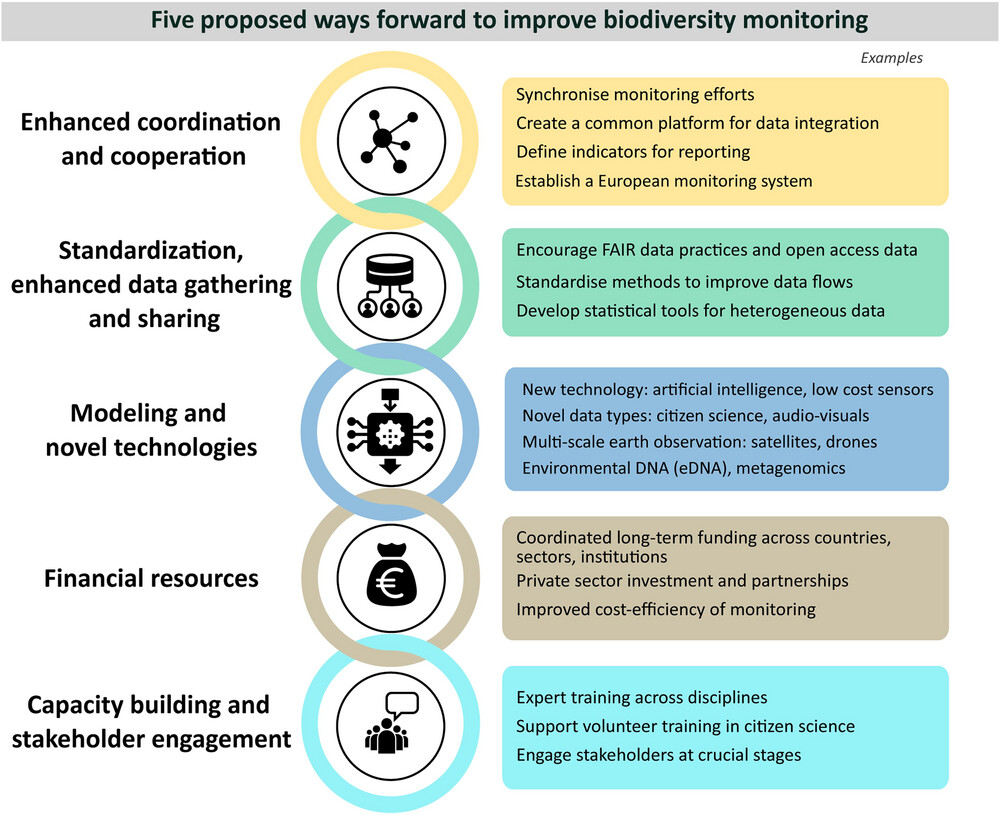
A new publication authored by scientists from the German Centre for Integrative Biodiversity Research (iDiv) and IIASA with a large European consortium provides vital insights into the current status of biodiversity monitoring in Europe, identifying policy needs, challenges, and future pathways.
According to the European Environment Agency, Europe’s biodiversity continues to decline at an alarming rate due to anthropogenic pressures and a warming climate. Improving biodiversity monitoring data is crucial to ensure effective implementation of the EU Biodiversity Strategy goals, successful conservation policies, and restoration management under the EU Nature Restoration Law.
However, knowing about data needs from users and policy makers is the first step toward achieving this. Those needs are assessed in the new iDiv-IIASA study published in Conservation Letters.
“Current monitoring efforts in Europe suffer from a variety of limitations, hindering their effectiveness. They are often fragmented across ecosystems and habitats with little continuity. For example, the environmental status of 20-70% of all EU marine regions is unknown,” says study lead author Hannah Moersberger from the Helmholtz Centre for Environmental Research (UFZ) and iDiv. “In addition, there is a lack of studies engaging directly with data users and policymakers to map their needs.”
Key findings
To address these issues, the scientists used a four-step user-centered stakeholder engagement process, which consisted of an international public stakeholder workshop, an online survey, semi-structured interviews, and an expert meeting with representatives of EU member states.
“The stakeholder engagement process saw strong participation from decision makers, including experts from 18 EU member states, the European Commission, and the European Environment Agency,” says study colead Juliette Martin, a research scholar jointly associated with the IIASA Population and Just Societies and Biodiversity and Natural Resources programs. “We wanted our study to be as inclusive as possible, covering all relevant stakeholders, and therefore also surveyed workshop participants, including experts from major natural history societies, museums, universities, and other research organizations.”
The survey conducted across Europe identified 274 biodiversity monitoring programs that are currently in place across European countries and agencies. The data reflected a bias in the attention paid to different biomes and species. Birds were, for instance, the most frequently monitored group, accounting for 28% of all monitoring efforts.
“In our study we systematically assessed the user and policy needs as well as regular uptake of monitoring data from structured monitoring and citizen science programs in national policy workflows,” says senior author Aletta Bonn, head of the Biodiversity and People research group at UFZ, iDiv, and the Friedrich Schiller University Jena.
“Our research identified and highlighted the many uses such data can have across a variety of sectors, whether for drawing up agricultural strategies, conservation and restoration plans, or managing hunting permits within a country,” explains study coauthor Jose Valdez from University Halle and iDiv.
The study identified four main clusters of key policy areas related to biodiversity monitoring within the next decade: assessing biodiversity and species trends; assessing biodiversity policy impact and effectiveness; integrating biodiversity in other policy sectors; and operationalization of monitoring.
Challenges and solutions
The study also identified the top ten challenges to current biodiversity monitoring activities in Europe. These were primarily associated with four major types of obstacles: lack of integrated data, insufficient data, insufficient resources, and biased data.
“The stakeholders involved in the study identified five ways to improve biodiversity monitoring and policy impacts in Europe,” says senior coauthor Ian McCallum, who leads the Novel Data Ecosystems for Sustainability (NODES) Research Group in the IIASA Advancing Systems Analysis Program. “These solutions include, enhanced coordination and cooperation, standardization for enhanced data gathering and dissemination, use of advanced models and new technologies, better coordination of financial resources and capacity building, as well as stakeholder engagement.”
Building on this study, a proposal for the European Biodiversity Observation Coordination Centre was presented by the EuropaBON consortium to the European Commission and the European Environment Agency in Brussels earlier this year.
“This is a major milestone for safeguarding biodiversity in Europe and facilitating modern, evidence-based policy and decision making for conservation and restoration management,” concludes Henrique Pereira, another author of the study, chair of the EuropaBON consortium, and head of the Biodiversity Conservation research group at iDiv and MLU.
Reference:
Moersberger, H., Valdez, J. Martin, J.G.C., Junker, J., et al. (2024). Biodiversity monitoring in Europe: user and policy needs. Conservation Letters. DOI: 10.1111/conl.13038
News

06 March 2025
Crafting narratives for a resilient and coherent Trans-European Nature Network

14 February 2025
Strengthening citizen science and sustainability monitoring in Europe

17 December 2024




